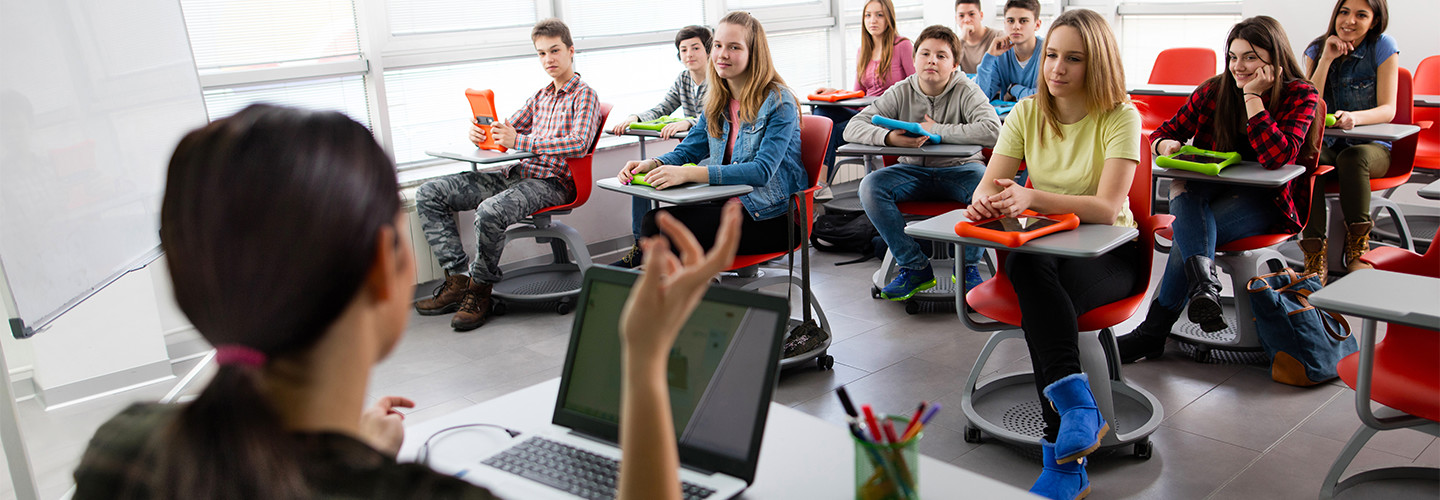ICE 2019: Physical Arrangement Sets the Tone for K–12 Modern Learning Environments
The design of any learning space typically sets the stage for the type of experience the students and teachers are going to have, said CDW•G Education Strategist Jennifer Brown at the 2019 Illinois Computing Educators conference in Schaumburg, Ill.
“When you walk into a room, you immediately have an invitation to the experience you are going to have in the space,” Brown said.
These experiences can range from the traditional lecture-style format to the emerging modern learning environments that are gaining in popularity.
Despite cultural and technological changes over the past several decades, one thing remained the same: the desks. Seating arrangements in most classrooms typically were set up in rows, with the teacher at the front of the room.
“The desks remained the same even though teachers were changing the way they taught,” Brown said. “We are just so conditioned to think this is what a classroom looks like. But it doesn’t have to look that way.”
JOIN THE CONVERSATION: Follow @EdTech_K12 on Twitter for continued ICE 2019 coverage.
Classroom Evolution Paves a Road for Modern Learning Environments
Why is it so important that schools reimagine their learning environments?
As workforce demands shift, classrooms will need to facilitate critical thinking and problem-solving skills to prepare students for emerging careers in data science, artificial intelligence and machine learning, Brown said.
“We are in the middle of the fourth industrial revolution,” Brown said. “The skills we are teaching are way more than just the Common Core. It is not working in rows anymore.”
Using classroom space to engage students has become paramount, and the modern learning environment plays a critical role in meeting students where they are.
“Your room should be able to facilitate different types of learning, in different ways, at different times.” Brown said.
What’s more, the environment needs to be agile so different kinds of learning can occur naturally and quickly. For example, equipping tables and chairs with wheels can help teachers manipulate their space to best fit their lesson plans without wasting a second.
“Lost instructional time is a thing — you need to milk every minute you have with them.”
Research Supports the Benefits of Modern Learning Environments
In a three-year study, researchers at the University of Minnesota were able to determine that students in an active-learning environment performed as well or better than their counterparts studying in a lecture-style format — and did so in a shorter amount of time.
While the study focused primarily on a higher education classroom, these findings are applicable to K–12 learning environments as well, according to Brown.
“Kids perform better when they can collaborate,” she said. “And you cannot help but change the way you are teaching when you are in that environment. … Do not just put flexible seating in your room if nothing else is going to change. Pedagogy needs to change too.”
DOWNLOAD: Get CDW's latest white paper on constructing modern learning environments.
4 Steps to a Modern Learning Environment
Brown offered several key steps educators can take to move toward a modern learning environment:
-
Create expectations and definitions: “Have you defined what the student learning experience is in your school or district?” Brown said. “What do you want them to get out of this redesign?”
-
Understand space vocabulary: Understanding important terms used to describe modern learning environments can help teachers and students understand how such an environment can support teaching, collaboration and digital spaces. For example, “adaptive” means the space adapts to expectations, “flexible” suggests space that can be reconfigured, and “agile” refers to how quickly a space can be reconfigured.
-
Ask students where they like to work, and why: “We need to talk to our kids,” Brown said. “Ask them, ‘What do you want to see in the space? What do you want to change?’”
-
Talk teachers through the benefits of a modern learning environment: Schools gain buy-in when their mission is rooted in meaning. “Show them the research,” Brown said. “Space design is not a trend.” By creating ownership with other stakeholders — including other teachers, administrators and members of the community — district leaders can change the tone of the conversation.
Steps Schools Can Take Today to Modernize the Classroom
For schools that can’t build out their ideal teaching environment right away, there are still steps teachers can take that can make a difference, Brown said.
Begin to envision the space: “Really pause and reflect to see what your students see,” she said.
Encourage student ownership: Start a conversation with students. Find out what they like about their classrooms now and what they think is lacking.
Reconfigure your teacher footprint: Tackle the challenging task of organizing the classroom to minimize wasted space, said Brown. “It’s so hard, but you have got to clean house. Decluttering is important,” Brown said.
Keep this page bookmarked for articles from the event. Follow us on Twitter at @EdTech_K12 or the official conference Twitter account, @ice.il, and join the conversation using the hashtag #ICE19.








